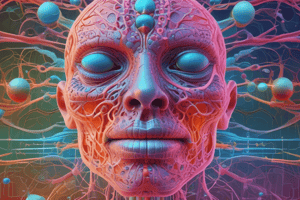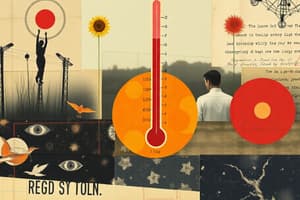Podcast
Questions and Answers
Which of the following is NOT a key component of homeostatic mechanisms?
Which of the following is NOT a key component of homeostatic mechanisms?
- Receptor
- Generator (correct)
- Effector
- Control Center
Positive feedback mechanisms always maintain stability in the body's internal environment.
Positive feedback mechanisms always maintain stability in the body's internal environment.
False (B)
What specific brain region acts as the control center for temperature regulation in the human body?
What specific brain region acts as the control center for temperature regulation in the human body?
hypothalamus
__________ is secreted by the pancreas to lower blood glucose levels.
__________ is secreted by the pancreas to lower blood glucose levels.
Match the type of pathogen with the corresponding infection it can cause:
Match the type of pathogen with the corresponding infection it can cause:
Which of the following is an example of vector-borne transmission?
Which of the following is an example of vector-borne transmission?
The innate immune system provides a specific and long-lasting response to pathogens.
The innate immune system provides a specific and long-lasting response to pathogens.
Which cells are responsible for producing antibodies?
Which cells are responsible for producing antibodies?
Explain the role of antigen presentation in the adaptive immune response.
Explain the role of antigen presentation in the adaptive immune response.
In the context of infection diagnosis, __________ tests are employed to identify the specific genetic material (DNA or RNA) of a pathogen, providing a definitive confirmation of its presence.
In the context of infection diagnosis, __________ tests are employed to identify the specific genetic material (DNA or RNA) of a pathogen, providing a definitive confirmation of its presence.
Flashcards
Homeostasis Definition
Homeostasis Definition
Maintaining a stable internal environment despite external changes.
Homeostasis Key Components
Homeostasis Key Components
Detects changes and signals the control center. The Control Center receives and coordinates a response from the Effector.
Negative Feedback
Negative Feedback
Reverses the change to maintain stability. e.g., body temperature regulation.
Temperature Regulation
Temperature Regulation
Signup and view all the flashcards
Blood Glucose Regulation
Blood Glucose Regulation
Signup and view all the flashcards
Infection
Infection
Signup and view all the flashcards
Direct Contact
Direct Contact
Signup and view all the flashcards
Droplet Transmission
Droplet Transmission
Signup and view all the flashcards
Physical Barriers
Physical Barriers
Signup and view all the flashcards
Adaptive Immune System
Adaptive Immune System
Signup and view all the flashcards
Study Notes
- Homeostasis is an organism's ability to maintain a stable internal environment despite external changes.
- It's crucial for cells, tissues, and organs to function correctly and survive.
- Homeostatic mechanisms continuously adjust body temperature, pH, blood glucose, and fluid balance, keeping them within specific ranges.
Key Components of Homeostasis
- Receptors detect internal or external environmental changes, signaling a control center.
- Control centers receive and process receptor information, coordinating a response.
- Effectors, like muscles or glands, carry out the response to restore balance.
- Negative feedback mechanisms reverse changes to maintain stability, such as body temperature regulation.
- Positive feedback mechanisms amplify initial changes for a rapid response, like blood clotting.
Temperature Regulation
- Maintaining a stable core body temperature, around 37°C in humans, is essential.
- Mechanisms to increase body temperature: shivering, vasoconstriction, and increased metabolism.
- Mechanisms to decrease body temperature: sweating, vasodilation, and decreased metabolism.
- The hypothalamus in the brain is the control center for temperature regulation.
Fluid and Electrolyte Balance
- Regulating water and electrolyte balance (ions) is crucial.
- Antidiuretic hormone (ADH) regulates water reabsorption in the kidneys.
- Aldosterone regulates sodium and potassium balance.
- Thirst and kidney function are key factors in maintaining fluid balance.
Blood Glucose Regulation
- Insulin, from the pancreas, lowers blood glucose by promoting glucose uptake by cells.
- Glucagon, also from the pancreas, raises blood glucose by stimulating glucose release from the liver.
- The liver and pancreas work together to keep blood glucose levels in a narrow range.
pH Balance
- Stable pH (around 7.35-7.45 in blood) is maintained through buffer systems, respiration, and kidney function.
- Buffers neutralize excess acids or bases in the blood.
- The lungs regulate pH by controlling blood carbon dioxide levels.
- The kidneys excrete acids or bases to maintain pH balance.
Disruptions of Homeostasis
- Imbalances in homeostatic mechanisms can lead to health issues and diseases.
- Diabetes results from impaired blood glucose regulation, either from insufficient insulin or insulin resistance.
- Dehydration occurs when fluid loss exceeds fluid intake, disrupting fluid and electrolyte balance.
- Heatstroke occurs when temperature regulation fails, leading to dangerously high body temperatures.
- Infections can disrupt homeostasis.
Infection
- Infection is the invasion and multiplication of pathogenic microorganisms in the body.
- Pathogens include bacteria, viruses, fungi, protozoa, and parasites.
Types of Pathogens
- Bacteria are single-celled organisms causing disease by releasing toxins or invading tissues directly, like Streptococcus.
- Viruses are infectious agents replicating inside host cells, causing cellular damage, such as influenza virus.
- Fungi are eukaryotic organisms causing infections on the skin, in the lungs, or systemically, like Candida.
- Protozoa are single-celled eukaryotic organisms causing diseases like malaria and giardiasis, such as Plasmodium.
- Parasites live on or inside a host organism and obtain nutrients from it, like tapeworms.
Transmission of Infections
- Direct contact: physical contact between an infected and a susceptible person, e.g., touching, kissing, or sexual contact.
- Indirect contact: occurs through contaminated objects (fomites) like surfaces or utensils, e.g., touching a contaminated doorknob.
- Droplet transmission: spread of pathogens through respiratory droplets from coughing or sneezing, e.g., influenza.
- Airborne transmission: spread of pathogens through small particles suspended in the air, e.g., tuberculosis, measles.
- Vector-borne transmission: spread of pathogens by vectors like mosquitoes or ticks, e.g., malaria, Lyme disease.
- Foodborne and waterborne transmission: occurs through contaminated food or water sources, e.g., Salmonella, E. coli, cholera.
Body's Defense Mechanisms
- Physical barriers: skin, mucous membranes, and cilia prevent pathogens from entering the body.
- Chemical barriers: secretions like saliva, tears, and stomach acid contain antimicrobial substances.
- The innate immune system provides a rapid, non-specific response.
- Includes cells like macrophages, neutrophils, and natural killer (NK) cells.
- Inflammation is a key component, with redness, swelling, heat, and pain.
- The adaptive immune system provides a specific and long-lasting response.
- Involves B cells and T cells.
- B cells produce antibodies that neutralize pathogens.
- T cells directly kill infected cells or help activate other immune cells.
- The adaptive immune system develops immunological memory.
Immune Response
- Antigen presentation: immune cells display pathogen-derived antigens to T cells.
- Activation of T cells leads to the production of cytotoxic and helper T cells.
- Cytotoxic T cells kill infected cells.
- Helper T cells activate B cells and enhance the activity of other immune cells.
- B cells differentiate into plasma cells, which produce antibodies.
- Antibodies bind to pathogens, neutralizing them or marking them for destruction.
- Memory cells are long-lived B and T cells that provide immunological memory.
Types of Infections
- Localized infections are confined to a specific area, e.g., skin or urinary tract infection.
- Systemic infections spread throughout the body via the bloodstream, e.g., sepsis.
Diagnosis of Infections
- Physical examination involves assessing symptoms and signs of infection.
- Laboratory tests include blood tests, urine tests, cultures, and imaging.
- Cultures involve growing pathogens from samples to identify the specific organism.
- Molecular tests detect pathogen DNA or RNA to confirm the presence of an infection.
Treatment of Infections
- Antibiotics treat bacterial infections.
- Antivirals treat viral infections.
- Antifungals treat fungal infections.
- Antiparasitics treat parasitic infections.
- Supportive care includes rest, hydration, and pain relief.
Prevention of Infections
- Vaccination involves administering weakened pathogens to stimulate an immune response.
- Hygiene practices like handwashing and covering coughs prevent the spread of infections.
- Sanitation and clean water sources are essential for preventing waterborne infections.
- Safe sexual practices prevent the transmission of sexually transmitted infections.
- Vector control measures reduce the risk of vector-borne diseases, e.g., mosquito control.
- Isolation precautions are used in healthcare settings to prevent the spread of infections.
Studying That Suits You
Use AI to generate personalized quizzes and flashcards to suit your learning preferences.




